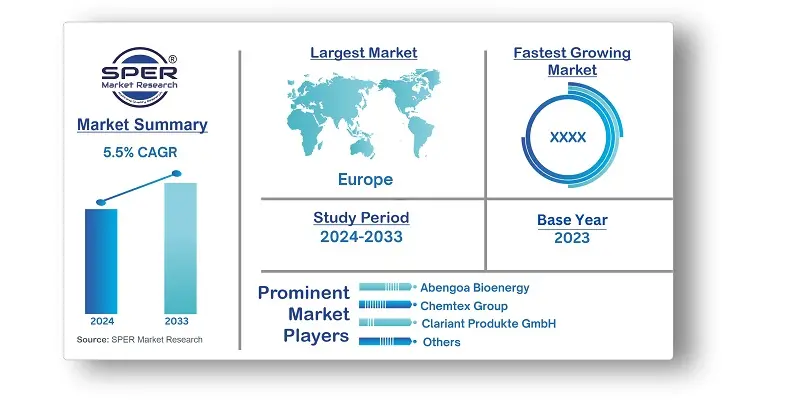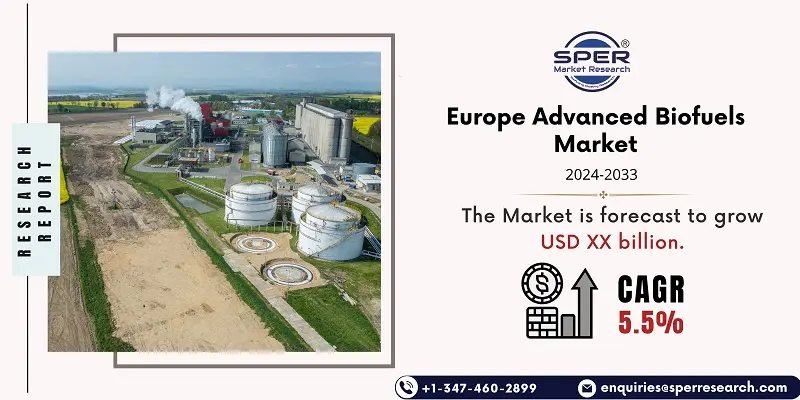
Europe Advanced Biofuels Market Growth, Size, Demand, Trends, Revenue and Future Outlook
Europe Advanced Biofuels Market Size- By Technology, By Raw Material, By Biofuel Type- Regional Outlook, Competitive Strategies and Segment Forecast to 2033
| Published: Apr-2024 | Report ID: POAE2427 | Pages: 1 - 153 | Formats*: |
| Category : Power & Energy | |||
- In July 2022, the German liner shipping company Hapag-Lloyd and DHL Global Forwarding, which specialises in air and ocean freight, inked a deal for the use of advanced biofuels. Hapag-Lloyd will use advanced biofuels to ship 18,000 TEU of DHL's volume as a first step, which equates to a 14,000 tonne decrease in Well-to-Wake CO2 emissions. Decarbonising container shipping and logistics is a shared vision between the two companies.
- In June 2022, in Ghent, Belgium, Cargill finished building its first cutting-edge advanced biodiesel plant. This facility turns leftovers and waste oils into sustainable fuel. Customers will be able to reduce the carbon footprint associated with their road transport and maritime activities by using the advanced biodiesel generated at the facility, which will be utilised by the trucking and maritime industries.


| Report Metric | Details |
| Market size available for years | 2020-2033 |
| Base year considered | 2023 |
| Forecast period | 2024-2033 |
| Segments covered | By Technology, By Raw Material, By Biofuel Type |
| Regions covered | France, Germany, Spain, United Kingdom, Rest of Europe |
| Companies Covered | Abengoa Bioenergy, Chemtex Group, Clariant Produkte GmbH, DuPont Industrial Biosciences, Envien Group, Greenergy International Ltd, INEOS Bio, Others |
- Energy Companies
- Automotive Industry
- Agricultural Sector
- Government Agencies and Regulatory Bodies
- Research Institutions and Universities
- Others
| By Technology: |
|
| By Raw Material: |
|
| By Biofuel Type: |
|
- Europe Advanced Biofuels Market Size (FY’2024-FY’2033)
- Overview of Europe Advanced Biofuels Market
- Segmentation of Europe Advanced Biofuels Market By Technology (Biochemical, Thermochemical)
- Segmentation of Europe Advanced Biofuels Market By Raw Material (Algae, Jatropha, Lignocellulose, Other Raw Materials)
- Segmentation of Europe Advanced Biofuels Market By Biofuel Type (Biobutanol, Biodiesel, Biogas, Cellulosic Ethanol, Other Biofuel Types)
- Statistical Snap of Europe Advanced Biofuels Market
- Expansion Analysis of Europe Advanced Biofuels Market
- Problems and Obstacles in Europe Advanced Biofuels Market
- Competitive Landscape in the Europe Advanced Biofuels Market
- Impact of COVID-19 and Demonetization on Europe Advanced Biofuels Market
- Details on Current Investment in Europe Advanced Biofuels Market
- Competitive Analysis of Europe Advanced Biofuels Market
- Prominent Players in the Europe Advanced Biofuels Market
- SWOT Analysis of Europe Advanced Biofuels Market
- Europe Advanced Biofuels Market Future Outlook and Projections (FY’2024-FY’2033)
- Recommendations from Analyst
1.1. Scope of the report1.2. Market segment analysis
2.1. Research data source2.1.1. Secondary Data2.1.2. Primary Data2.1.3. SPER’s internal database2.1.4. Premium insight from KOL’s
2.2. Market size estimation
2.2.1. Top-down and Bottom-up approach2.3. Data triangulation
4.1. Driver, Restraint, Opportunity and Challenges analysis4.1.1. Drivers4.1.2. Restraints4.1.3. Opportunities4.1.4. Challenges4.2. COVID-19 Impacts of the Europe Advanced Biofuels Market
5.1. SWOT Analysis5.1.1. Strengths5.1.2. Weaknesses5.1.3. Opportunities5.1.4. Threats5.2. PESTEL Analysis5.2.1. Political Landscape5.2.2. Economic Landscape5.2.3. Social Landscape5.2.4. Technological Landscape5.2.5. Environmental Landscape5.2.6. Legal Landscape5.3. PORTER’s Five Forces5.3.1. Bargaining power of suppliers5.3.2. Bargaining power of buyers5.3.3. Threat of Substitute5.3.4. Threat of new entrant5.3.5. Competitive rivalry5.4. Heat Map Analysis
6.1. Europe Advanced Biofuels Market Manufacturing Base Distribution, Sales Area, Product Type6.2. Mergers & Acquisitions, Partnerships, Product Launch, and Collaboration in Europe Advanced Biofuels Market
7.1. Europe Advanced Biofuels Market Value Share and Forecast, By Technology, 2024-20337.2. Biochemical7.3. Thermochemical
8.1. Europe Advanced Biofuels Market Value Share and Forecast, By Raw Material, 2024-20338.2. Algae8.3. Jatropha8.4. Lignocellulose8.5. Other Raw Materials
9.1. Europe Advanced Biofuels Market Value Share and Forecast, By Biofuel Type, 2024-20339.2. Biobutanol9.3. Biodiesel9.4. Biogas9.5. Cellulosic Ethanol9.6. Other Biofuel Types
10.1. Europe Advanced Biofuels Market Size and Market Share
11.1. Europe Advanced Biofuels Market Size and Market Share By Technology (2020-2026)11.2. Europe Advanced Biofuels Market Size and Market Share By Technology (2027-2033)
12.1. Europe Advanced Biofuels Market Size and Market Share By Raw Material (2020-2026)12.2. Europe Advanced Biofuels Market Size and Market Share By Raw Material (2027-2033)
13.1. Europe Advanced Biofuels Market Size and Market Share By Biofuel Type (2020-2026)13.2. Europe Advanced Biofuels Market Size and Market Share By Biofuel Type (2027-2033)
14.1. Europe Advanced Biofuels Market Size and Market Share By Region (2020-2026)14.2. Europe Advanced Biofuels Market Size and Market Share By Region (2027-2033)14.3. France14.4. Germany14.5. Spain14.6. United Kingdom14.7. Rest of Europe
15.1. Abengoa Bioenergy15.1.1. Company details15.1.2. Financial outlook15.1.3. Product summary15.1.4. Recent developments15.2. Chemtex Group15.2.1. Company details15.2.2. Financial outlook15.2.3. Product summary15.2.4. Recent developments15.3. Clariant Produkte GmbH15.3.1. Company details15.3.2. Financial outlook15.3.3. Product summary15.3.4. Recent developments
15.4. DuPont Industrial Biosciences
15.4.1. Company details15.4.2. Financial outlook15.4.3. Product summary15.4.4. Recent developments15.5. Envien Group15.5.1. Company details15.5.2. Financial outlook15.5.3. Product summary15.5.4. Recent developments15.6. Greenergy International Ltd15.6.1. Company details15.6.2. Financial outlook15.6.3. Product summary15.6.4. Recent developments15.7. INEOS Bio15.7.1. Company details15.7.2. Financial outlook15.7.3. Product summary15.7.4. Recent developments15.8. Others
SPER Market Research’s methodology uses great emphasis on primary research to ensure that the market intelligence insights are up to date, reliable and accurate. Primary interviews are done with players involved in each phase of a supply chain to analyze the market forecasting. The secondary research method is used to help you fully understand how the future markets and the spending patterns look likes.
The report is based on in-depth qualitative and quantitative analysis of the Product Market. The quantitative analysis involves the application of various projection and sampling techniques. The qualitative analysis involves primary interviews, surveys, and vendor briefings. The data gathered as a result of these processes are validated through experts opinion. Our research methodology entails an ideal mixture of primary and secondary initiatives.



Frequently Asked Questions About This Report
PLACE AN ORDER
Year End Discount
Sample Report
Pre-Purchase Inquiry
NEED CUSTOMIZATION?
Request CustomizationCALL OR EMAIL US
100% Secure Payment






Related Reports
Our Global Clients
Our data-driven insights have influenced the strategy of 200+ reputed companies across the globe.




















